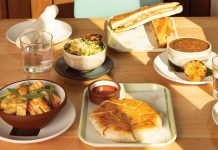
Kitchens breed two kinds of burgers: There’s the thick single patty—a backyard classic that’s tossed on a grill and singed by fire. And then there’s the thin double patty that sizzles and sears on a flattop, its edges all crisp and crunch. Menus today favor the latter, but at a price: Double patties are inconsistent. Even our most well-known double patties—at Bocado, Holeman and Finch Public House, or One Eared Stag—suffer from mood swings. After all, it’s easy to overcook a thin burger, to speed past that critical point of “cooked and juicy” and nosedive into “burned and dry.” A thick slab of beef is far more forgiving.
Linton Hopkins had the right idea: Limit the quantity and narrow the cooking window. It forced his staff at Holeman and Finch to master 12 burgers at a time from 10 to 10:20 p.m. on one flattop. However exclusive, hyped-up, and drawn-out the experience was for customers, the burgers were handled uniformly. And they rocked. But this was all before Hopkins got a new idea and started pimping out his burgers across town. An expanding crop of burger stands does signal good business sense, but it’s unlikely that these future double stacks will grasp the magic of the original.
This article originally appeared in our January 2015 issue.













